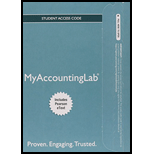
1.
Liabilities: Liabilities are debt and obligations of a business. These are the claims against the resources that a business owes to outsiders of the company. Liabilities may be short-term or long-term depending upon the time duration in which it is paid back to the creditors.
To report: Liabilities on the balance sheet.
2.
Debt to equity ratio: Debt to equity ratio is used to evaluate the relationship between the total liabilities and total equity of the company. Debt to equity ratio helps the company to determine the proportion of debt and equity. When the ratio is greater than 1, then it is higher and thus, company faces higher risk. Debt to equity ratio is calculated by using the following formula:
To calculate: Debt to equity ratio.
Want to see the full answer?
Check out a sample textbook solution
Chapter 12 Solutions
MyLab Accounting with Pearson eText -- Access Card -- for Horngren's Financial & Managerial Accounting (My AccountingLab)
- Financial accountingarrow_forwardHatfield Corporation, which has only one product, has provided the following data concerning its most recent month of operations: Selling price $158 Units in beginning inventory 100 Units produced 1,720 Units sold 920 Units in ending inventory 900 Variable costs per unit: Direct materials $59 Direct labor $37 Variable manufacturing overhead $6 Variable selling and administrative $9 Fixed costs: Fixed manufacturing overhead $15,480 Fixed selling and administrative $17,480 What is the total period cost for the month under the variable costing? A- $32,960 B- $25,760 C- $41,240 D- $15,480arrow_forwardHelparrow_forward
- How much Total sales are required to achieve a net income of 160000?arrow_forwardGeneral accounting questionarrow_forwardHamilton Biotech has a profit margin of 8% and an equity multiplier of 2.8. Its sales are $150 million, and it has total assets of $60 million. What is Hamilton Biotech's Return on Equity (ROE)? Round your answer to two decimal places.arrow_forward
- MAX's Auto Repair, a proprietorship, started the year with total assets of $72,000 and total liabilities of $48,500. During the year, the business recorded $120,600 in repair revenues, $65,400 in expenses, and MAX Grant, the owner, withdrew $12,500. MAX’s capital balance at the end of the year?arrow_forwardWhat is equity at the end of the year is?arrow_forwardPlease help mearrow_forward
 Cornerstones of Financial AccountingAccountingISBN:9781337690881Author:Jay Rich, Jeff JonesPublisher:Cengage Learning
Cornerstones of Financial AccountingAccountingISBN:9781337690881Author:Jay Rich, Jeff JonesPublisher:Cengage Learning Financial AccountingAccountingISBN:9781305088436Author:Carl Warren, Jim Reeve, Jonathan DuchacPublisher:Cengage Learning
Financial AccountingAccountingISBN:9781305088436Author:Carl Warren, Jim Reeve, Jonathan DuchacPublisher:Cengage Learning Managerial Accounting: The Cornerstone of Busines...AccountingISBN:9781337115773Author:Maryanne M. Mowen, Don R. Hansen, Dan L. HeitgerPublisher:Cengage Learning
Managerial Accounting: The Cornerstone of Busines...AccountingISBN:9781337115773Author:Maryanne M. Mowen, Don R. Hansen, Dan L. HeitgerPublisher:Cengage Learning- Principles of Accounting Volume 1AccountingISBN:9781947172685Author:OpenStaxPublisher:OpenStax College
 Intermediate Accounting: Reporting And AnalysisAccountingISBN:9781337788281Author:James M. Wahlen, Jefferson P. Jones, Donald PagachPublisher:Cengage Learning
Intermediate Accounting: Reporting And AnalysisAccountingISBN:9781337788281Author:James M. Wahlen, Jefferson P. Jones, Donald PagachPublisher:Cengage Learning




